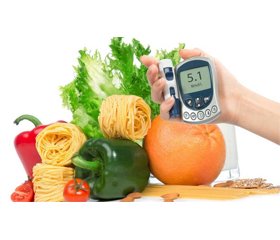Международный эндокринологический журнал Том 17, №6, 2021
Вернуться к номеру
Вибір дієти та харчових звичок для хворих на цукровий діабет 2-го типу та членів їх родин
Авторы: Dikha Ayu Kurnia, Yulia Yulia
Medical Surgical Nursing Department, Faculty of Nursing, Universitas Indonesia
Рубрики: Эндокринология
Разделы: Клинические исследования
Версия для печати
Актуальність. Поширеність цукрового діабету 2-го типу (ЦД2) зростає з року в рік, особливо в Індонезії. Ризик виникнення ЦД2 розпочинається за обіднім столом у родині. Планування харчування відіграє важливу роль у зменшенні можливих ускладнень, пов’язаних з поганим контролем глікемії, ліпідограми й артеріального тиску. Акцент на зменшення споживання цукру, жиру і солі та дотримання відповідного режиму харчування сприяють покращенню прихильності до менеджменту ЦД. Однак у пацієнтів з ЦД2 виникають різноманітні розлади харчування, при яких існує розрив між реальним харчуванням і контролем за його режимом. Метою дослідження є вивчення навичок і знань пацієнта з цукровим діабетом та членів його родини щодо вибору їжі та способу харчування під час захворювання. Матеріали та методи. Під спостереженням перебували пацієнти з ЦД2 та члени їх родин у Джакарті (Індонезія): 14 хворих і 7 членів їх родин. Аналізували дані, отримані під час спостереження за учасниками дослідження та шляхом їх детального опитування. Використовували описовий феноменологічний метод із напівструктурованим поглибленим опитуванням. Інтерв’ю проводилися віч-на-віч із жовтня 2017 року по липень 2018 року та аналізувалися за допомогою тематичного аналізу за методом Collaizi. Результати. Це дослідження виявило 4 важливі аспекти: 1) доведено, що надмірне вживання їжі впливає на високий рівень цукру у крові; 2) необхідно змінювати режим харчування на тлі ЦД; 3) головна турбота родини — забезпечити раціональне харчування, але не робити це тягарем для хворого; 4) виклик, з яким стикаються учасники дослідження та члени їх родини, — це відсутність належної інформації. Дослідження рекомендує продовжувати навчання хворих і посилювати співпрацю середнього медичного персоналу щодо важливості взаємозв’язку між режимом харчування та рівнем глюкози у крові. Висновки. Люди схильні покладатися на прості стратегії, що забезпечують раціональне харчування. Здатність пацієнтів і членів їх родин підбирати харчові інгредієнти та підтримувати стабільність цукру у крові — це завдання середнього медичного персоналу. Етикетки харчових продуктів можуть надавати (і певною мірою надають) широкий спектр необхідної інформації, починаючи від складу харчових продуктів і закінчуючи деталями виробництва, вмістом вуглеводів.
Background. The prevalence of type 2 diabetes mellitus (T2DM) is increasing from year to year, especially in Indonesia. The risk of T2DM starts at the dinner table in the family. Meal planning plays an important role in reducing the potential complications associated with poor glycemic, lipid and blood pressure control. Focusing on reducing sugar, fat and sodium intake and incorporating culture-appropriate foods will improve adherence. However, T2DM patients develop conflicting eating disorders in which there is a gap between nutrition and self-fulfillment regarding eating control. The purpose of this research is to explore the understanding of the diabetes patient and their family in determining the selection of food and eating pattern during the disease. Materials and methods. This study explores the understanding of T2DM patients and their families in the Depok and Jakarta. The purposive sampling method used 14 participants and 7 family members. The data obtained from participant observation and in-depth interviews then analyzed using thematic analysis. Using a descriptive phenomenological method with a semi structured in-depth interview. The interviews were conducted face to face from October 2017 — July 2018 and were analyzed by thematic analysis Collaizi’s method. Results. This study found 4 important themes: 1) food is believed to affect high blood sugar; 2) changes in diet after diabetes; 3) the main concern of the family is to keep eating but not make it a burden; and 4) the challenge faced by participants and their families is the lack of information. This study recommends continuing education and partnerships from nurses about the importance of the relationship between diet and blood glucose levels. Conclusions. People are inclined to rely on simple strategies that limit search when making food choices. The ability of patients and families regarding food ingredients to maintain blood sugar stability is the concern of nurses in providing nutritional education. Food labels can (and to some extent do) provide a wide variety of desirable information, ranging from food content to production details, the food’s carbon footprint, and its origins.
цукровий діабет 2-го типу; дієта; родина; харчування; вибір
type 2 diabetes mellitus; diet; family; food; selection
Introduction
Materials and methods
Result
Discussion
Conclusions
- American Diabetes Association. Classification and Diagnosis of Diabetes: Standards of Medical Care in Diabetes-2020. Diabetes Care. 2020. 43(suppl. 1). S14-S31. doi: 10.2337/dc20-S002.
- Secker D., Jeejeebhoy K. Regarding the article “Subjective global assessment of nutritional status in children” by Mahdavi et al. Matern. Child Nutr. 2011. 7(2). 215. Author reply 216. doi: 10.1111/j.1740-8709.2010.00292.x.
- Franz M.J., Powers M.A., Leontos C., Holzmeister L.A., Kulkarni K., Monk A., Wedel N., Gradwell E. The evidence for medical nutrition therapy for type 1 and type 2 diabetes in adults. J. Am. Diet. Assoc. 2010. 110(12). 1852-89. doi: 10.1016/j.jada.2010.09.014.
- Raj D., Devi G. Dietary Adherence and Food Acceptability among Individuals with Type 2 Diabetes. ProQuest Dissertations and Theses. University of Alberta, 2012. https://doi.org/10.7939/R3XD9S
- Nadeau J., Koski K.G., Strychar I., Yale J.F. Teaching subjects with type 2 diabetes how to incorporate sugar choices into their daily meal plan promotes dietary compliance and does not deteriorate metabolic profile. Diabetes Care. 2001. 24(2). 222-7. doi: 10.2337/diacare.24.2.222.
- Tsihlias E.B., Gibbs A.L., McBurney M.I., Wolever T.M. Comparison of high- and low-glycemic-index breakfast cereals with monounsaturated fat in the long-term dietary management of type 2 diabetes. Am. J. Clin. Nutr. 2000. 72(2). 439-49. doi: 10.1093/ajcn/72.2.439.
- Rintala T.-M., Jaatinen P., Paavilainen E., Åstedt-Kurki P. Interrelation Between Adult Persons With Diabetes and Their Family. J. Fam. Nurs. 2013. 19(1). 3-28. DOI: 10.1177/1074840712471899.
- Kaplan S.H., Greenfield S., Ware J.E. Jr. Assessing the effects of physician-patient interactions on the outcomes of chronic disease. Med. Care. 1989. 27(3 suppl.). S110-27. doi: 10.1097/00005650-198903001-00010.
- Schulte-Mecklenbeck M., Sohn M., de Bellis E., Martin N., Hertwig R. A lack of appetite for information and computation. Simple heuristics in food choice. Appetite. 2013. 71. 242-51. doi: 10.1016/j.appet.2013.08.008.

